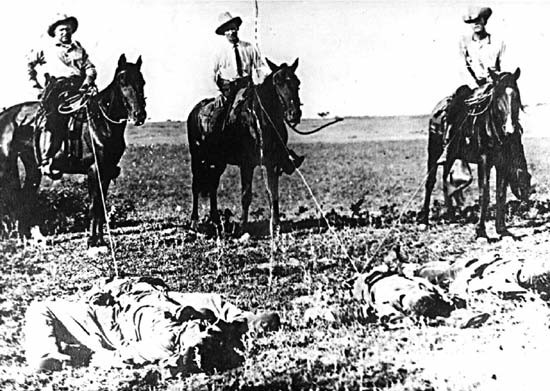|
Kirby Warnock investigates his grandfather's indictment of the Texas Rangers Then said Gregorio Cortez, In 1915, Roland Warnock, then a 19-year-old working at the McAllen Ranch, witnessed a team of Texas Rangers shoot and kill 67-year-old Jesus Bazan and Bazan's son-in-law, Antonio Longoria. The elder Warnock's recollection, preserved on tape, and the ensuing investigation into its veracity, are the subject of the documentary film Border Bandits, directed by Warnock's grandson Kirby, who first heard the story as a child and later recorded it in 1975, shortly before his grandfather's death.
"The thought of the Texas Rangers shooting an unarmed man in the back was unbelievable - but also unthinkable," Kirby Warnock says, in voice-over, of his reaction to his grandfather's story; later, the film's narrator comments how "most Texans" would find it hard to believe the Rangers were capable of such atrocities. As a white Texan, Warnock essentializes his experience for all Texans; while this move marginalizes the film's Mexican American viewers it opens up a space for identification among the Anglos in the audience who may have approached the subject with the same sense of disbelief or doubt he initially held. Here, in clearly elucidated terms, is an occurrence which has profoundly disrupted Warnock's belief in the impartiality of law and order, a point he returns to time and time again. Initially, Warnock's investigation centered upon the details of Bazan's and Longoria's murder as if it was an isolated incident. With each new piece of evidence or bit of research he uncovers, he builds a case suggesting that the Rangers engaged in systemic, deliberate violence with impunity. In a sly, almost objective, manner of self-reflection, Warnock reveals that Roland Warnock's father was gunned down by one of the Rangers he identified as shooting the two unarmed men. Since Warnock's great-grandfather was a white man, the killing went to trial (although the Ranger was acquitted); the killing of Bazan and Longoria didn't even warrant death certificates. They were just two more dead Mexicans out of an estimated 5,000 individuals (a conservative figure, uncredited in the film but most likely coming from Ranger historian Walter Prescott Webb) who lost their lives during this time period - men, women, children who committed no other crime than to be born brown in a now-white Texas. At the peak of the "bandit era," while Rangers boasted of killing 14 men, "not counting Mexicans," the San Antonio Express announced it would no longer run stories about murdered Mexican Americans. Chillingly, the documentary shows postcards of victims, like the popular shot of Mexicanos bound and tied to a trio of horses, which made the rounds, much like the images of lynched blacks in other parts of the South. Combined, these acts all served to dehumanize the Texas-Mexican population at a moment of transition and definition, both for the state and the nation.
During the course of the film one historian observes that "anybody who looked like he might be a bandit was a target," which meant, in practical terms, anyone with brown skin. "Border bandits" and "the bandit war" conflated horse thieves, revolutionaries, and ranch hands at a time when white Texans used force and intimidation to determine and define their collective identity: who they were and, as importantly, who they were not. Nine decades after the events which the elder Warnock recounted and the younger Warnock preserved, modern-day Texas remains, in many aspects, very similar to the old one. Speaking to the shifting demographics of the region, one commentator's optimism that we are fast becoming the majority is tempered by the knowledge that numbers alone won't ensure a peaceful transference of power. As long as this state, and this nation, remains in denial of the violent, oftentimes deadly, legal, and extralegal means it used to secure and preserve Anglo superiority - glossed over in a myth of good intentions and western expansion, of protecting the borders and defending property - the granddaughters and grandsons of Bazan and Longoria, along with the 5,000 others who lost their lives and the countless more who bore witness or suffered needlessly under Ranger, rancher, and vigilante rule, will continue to thirst for justice and hunger for a more complex history which tells all our stories, even those parts we'd rather leave out. •
|


